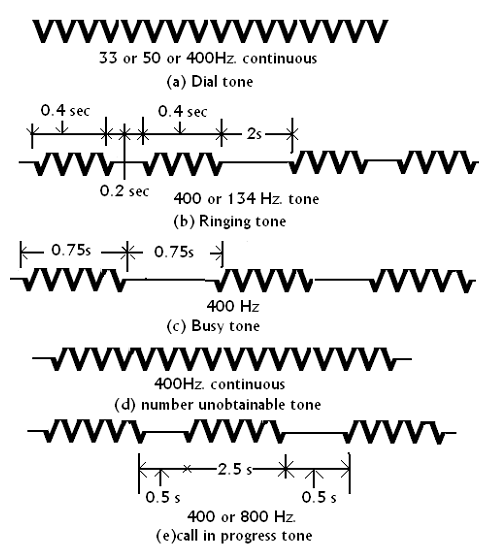What are the different tones used in strowger telephony? Explain with the help of waveforms and the timings.
Dial Tone: it is used to indicate that the exchange is ready to recognize dialed digits by the subscriber. The subscriber must start dialing simply after hearing the dialing tone. However, sometimes, a few seconds may elapse before the dial tone is heard. It happens particularly in general control exchanges that use shared resources for user interfaces. The dial tone is a 50 Hz or 33 Hz or 400 Hz continuous tone as demonstrated in Fig. The 400 Hz signal is typically modulated with 50 Hz or 25 Hz.
When the called party line is acquired, the exchange control equipment sends out the ringing current to the telephone set of the called party. Such ringing current has the familiar double-ring pattern. At once, the control equipment sends out a ringing tone to the calling subscriber that has a pattern similar, which of the ringing current as demonstrated in Fig. The two rings in the double ring pattern are separated through a time gap of 0.2 s and two double ring patterns with a gap of 2 s. The ring burst has period of 0.4 s. The frequency of the ringing tone is 133 Hz or 400 Hz,
Busy tone pattern is demonstrated in figure. This is a bursty 400 Hz signal with silence era in between. The burst and silence duration contain the similar value of 0.75 s or 0.375 s. A busy tone is sent to the calling subscriber when the switching equipment or junction line is not obtainable to put through the call or the called subscriber line is engaged.
In the following figure illustrates the number unobtainable tone that is continuous 400 Hz signal. This tone might be sent to the calling subscriber because of a variety of reasons as the called party line is out of order or disconnected, and an error in dialing leading to the selection of a spare line. In the several exchanges the number unobtainable tone is 400 Hz intermittent along with 2.5 s on period and 0.5 s off period.

FIG - Signaling Tones in Automatic Exchange
The call-in-progress tone or routing tone is a 400 Hz or 800 Hz intermittent pattern. In electromechanical systems, this is generally 800 Hz with 50 percent duty ratio and 0.5 s on/off period. This is a 400 Hz pattern with 0.5 s on period and 2.5 s off period, in analog electronic exchanges. In digital exchanges, this has 0.1 s on/off periods at 400 Hz. While a subscriber call is routed by a number of different types of exchanges, one hears various call-in-progress tones as the call progresses by different exchanges. Figure shows a routing tone pattern.